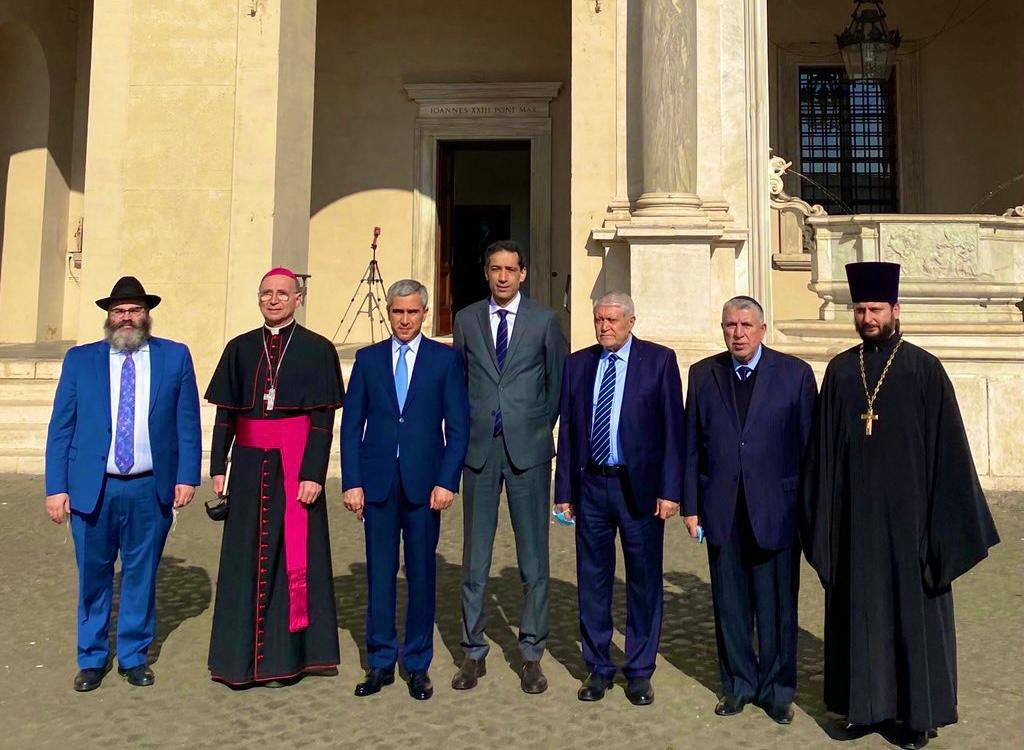
I have recently returned to my home in Baku after traveling to Rome as part of a delegation of Azerbaijani faith and community leaders. The visit was organized by the renowned Heydar Aliyev Foundation of Azerbaijan, an organization – led by First Vice President and UNESCO Goodwill Ambassador Mehriban Aliyeva – dedicated to preserving and protecting cultural, historical and religious heritage that has, among others, also restored many ancient churches in Azerbaijan, France, Russia, Greece and Bulgaria. A component of our visit was to participate in the signing of a new agreement, a cooperative partnership toward the restoration of the Catacombs of Commodilla, signed by Cardinal Gianfranco Ravasi, President of the Pontifical Commission for Sacred Archaeology and Anar Alakbarov, Executive Director of the Heydar Aliyev Foundation.
For those unfamiliar with our distinct history, it may seem unusual for a delegation of leaders representing a 95% majority Muslim country to celebrate at the Vatican the embarkment of such collaboration. Yet those familiar with Azerbaijan know it is the key factor of our success in most areas of life. We place extraordinarily high value on religious and cultural heritage, and we consider the honoring and preservation of Christian artifacts as precious and important as artifacts representing any faith. To that point, my part in the delegation was in representation of the Mountain Jewish Community of Baku, of which I am the Chairman. As an Azerbaijani Jew, I have an intimate understanding of the importance of cultural preservation, as I come from a line of people that still exists today because of Azerbaijan’s active, thriving commitment to cultural respect and protection, which has been in place for centuries.
Azerbaijan has also experienced the tragic side of the issue, where in the process of the nearly 30 years of illegal occupation of Azerbaijan’s Karabakh region by Armenia, hundreds of historic structures, including monuments, museums, galleries of art, and countless homes were destroyed. Out of 67 Azerbaijani mosques that were in Karabakh, only few survived. Many mosques were turned into cow and pig sheds. Even graveyards, the resting place for generations of Azerbaijani families, were razed to the ground, ravaged and obliterated. These acts didn’t occur hundreds of years ago, but in the last 30 years, since the invasion began and up until the end of the war, which came about in November 2020, when Armenia was forced to withdraw its troops from Azerbaijan’s occupied territories as a result of the 44-day war. Azerbaijan is now involved in the immense responsibility of addressing these damages and revitalizing Karabakh so that the nearly 1 million forcibly displaced Azerbaijanis can return to their home towns they once fled. Our nation will work to restore not only the homes but the elements of heritage, the character of Karabakh – a haven of creativity, culture and tradition that has lasted throughout the tests of time. But it will be an incomparable challenge, if only a righteous one. How do you rebuild history, how do you transplant a heart back into a city, where it was ripped out, gutted and burned to ashes? My only thought is that you do it with hope, and perhaps some help. And in that vein, our commitment to historical and cultural preservation goes far beyond the borders of our nation, to the Vatican and well beyond.
Despite these tragedies, our work promoting and acting on the values of multicultural and multifaith harmony carries on as strong as ever in Azerbaijan, where Muslims of both Shiite and Sunni tradition, Christians of various denominations, including Armenian Orthodox, as well as Baháʼís, Hare Krishnas, and three distinct communities of 30,000 Jews all live together in harmony, as we have for centuries. I saw the strength of this on our visit to the Vatican. As expected, my fellow delegates, including Deputy Chairman of the Caucasus Muslims’ Office and Rector of Baku Islamic University Dr. Sabir Hasanli, Father Mefodi and Bishop Vladimir Fekete visited many important sites within the Vatican and in Rome, and spent time in the new museum of the St. Sebastian catacombs and the sarcophagi, which the Heydar Aliyev Foundation helped to restore. I saw this in the warmth of our hosts, and the history we share of working together on the effort to restore and preserve heritage. And in preserving heritage, in showing the utmost care and respect to the history of another’s faith, and to any faith or culture, we are in fact building a future. It is a cycle, and a circle of intention, values and courage, where we recognize what is precious about yesterday so that we can build a tomorrow that recognizes the same in others. That is the key ingredient of Azerbaijan’s every success, and I believe the key ingredient to a world of peace and harmony, one day soon.
Related posts:
Views: 0
 RSS Feed
RSS Feed















 March 19th, 2021
March 19th, 2021  Awake Goy
Awake Goy  Posted in
Posted in  Tags:
Tags: 
















